
The combination of the Winchester Model 71 rifle and 348 Winchester cartridge are placed into historical context in Part 1. Part 2 addresses handloading the 348 Winchester and the live fire experience with the Model 71.
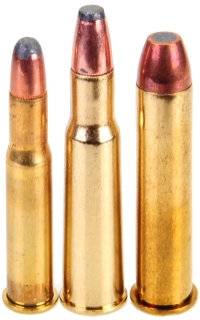 The 348 Winchester shares a case head and rim diameter with the 50-110 Winchester, a cartridge introduced in 1887 as a Winchester Model 1886 chamber. Perhaps the 348 Winchester can be considered an early short magnum, as it is a shortened and necked down derivative of the 50-110 WCF.
The 348 Winchester shares a case head and rim diameter with the 50-110 Winchester, a cartridge introduced in 1887 as a Winchester Model 1886 chamber. Perhaps the 348 Winchester can be considered an early short magnum, as it is a shortened and necked down derivative of the 50-110 WCF.
Case capacity of the 348 WCF varies with source, but stated somewhere between 75 and 80 grains of H2O at spill over full. New, unfired, 348 Winchester brass wet checked at 76 grains. Net capacity with bullet seated is indicated on the handload data table.
Placing the 348 Winchester within a framework of relative size, the 30-30 WCF (near right) is a 44 grain case and the 45-70 Gov’t (far right) is a 79 grain case. As a relationship amongst case volume, bore capacity and pressure, an indication of bore wear and relative barrel length requirements, the 348 WCF has a Real Guns®Barrel Burner Index of 10, the 30-30 WCF rates an 8 and the 45-70 a 4. By comparison, even the moderate 30-06 Springfield has a rating of 13. The combination of the Winchester Model 71 and 348 WCF cartridge was designed to function reliably and to last a very long time.
Availability of ammo and components
Other than the current ammunition shortage dilemma, 348 WCF factory ammunition is available from at least three companies; Big Bore, Grizzly and Winchester, with Winchester limited to seasonal runs. The cost is roughly $80/box 20. Components and reloading tools are available through most large online discount retailers.
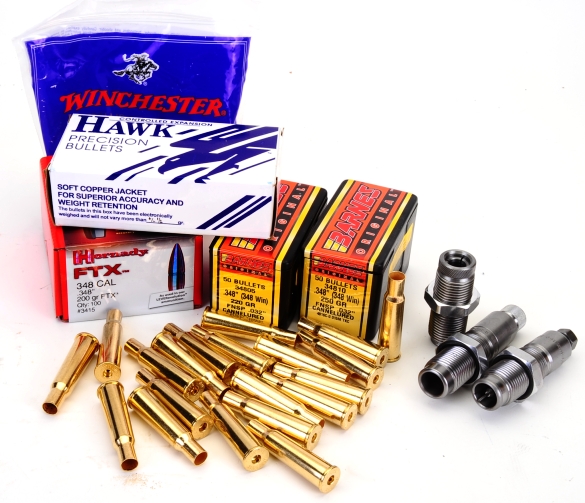
Winchester, Jamison and Quality Cartridge produce new brass so that one brand or another is readily available. Reloading dies are produced by Hornady, Lee, RCBS and Redding. Jacketed bullets are offered by Barnes, Hawk Precision, Hornady, Swift and Woodleigh. Cast bullets are available from Montana Bullet Works, Bear Tooth Bullets and casting molds and dies are available from the usual cast of characters. Locating bullets in retail inventory isn’t difficult, which is a surprise considering there is no other .348″ cartridge that shares bullets with the 348 Winchester and all components have generally been in short supply. Below are the four bullets selected for the project.
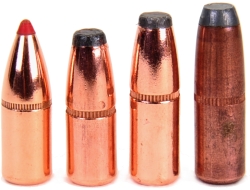
| Manufacturer | Type | Grains | Length | BC |
| Barnes Original | FP | 220 | 1.050 | .301 |
| Barnes Original | FP | 250 | 1.170 | .327 |
| Hawk Precision | FP | 270 | 1.207 | .325 |
| Hornady FTX | SP | 200 | 1.122 | .320 |
The Barnes Original bullets have tough jacketed lead cores and flat noses. They also represent two of the popular 348 WCF bullet weights. The Hawk Precision is a heavy for 0.348″ and has a dead soft 0.035″ copper jacket. They expand nearly three times original size while retaining a high degree of their original weight.
Handloading comments
The somewhat limited number of jacketed bullet producers means limited sources of tested and verified load data. As an example, neither Nosler, Speer nor Sierra include load data in their manuals because they do not make, or no longer make, 0.348″ bullets. Both Hornady and Barnes still include load data for the 348 Winchester. The 348 Winchester is well represented in P.O. Ackley’s Handbook for Shooters and Handloaders, The current Lyman reloading handbook, and many older Lyman and Speer reloading handbooks contain extensive 348 Winchester reloading data.
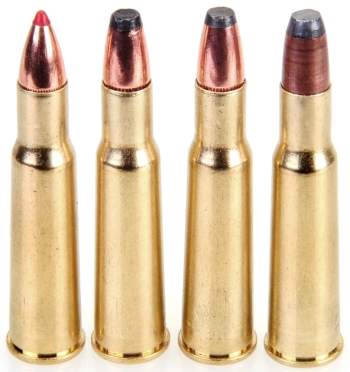
Unlike some cartridges utilizing FTX bullets, the 348 Winchester does not require special case length trimming to make spec cartridge overall length, it crimps to the cannelure at 2.795″. Barnes Original bullets presented no problem at all, in that regard, but the 2.795 COL is a Model 71 hard limit.
The Hawk Precision bullet did present a problem when seated to the cannelure in that they exceeded maximum COL and would not feed from the Model 71’s magazine. It appears the cannelure was positioned incorrectly… by about the thickness of the cannelure. Bullets were seated to the maximum cartridge overall length and a Lee Factory Crimp Die was used during assembly. Hawk Precision’s FAQ’s noted that a Lee Crimp Die can be used on their bullets where no cannelure exists because of their bullet’s dead soft copper jackets.
The seater plug in the Lee set worked well with traditional flat tip bullets, but the nose of the plug was cut at too steep of an angle to catch the Hornady FTX ogive shape without the plug being screwed all the way in and the die body screwed into the press to the maximum. We made a new plug with a more appropriate shape on the lathe for the sake of expediency, however, custom plugs can be ordered from Lee and any other die maker.
Powder selection… Re17, Re19 and H414. No luck at all with IMR4350 or a few others that were incorporated into the first handload pass. There were no pressure problems, just underperformance in accuracy or velocity with reasonable powder charges.
 |
|
||||||||||||
|
|
|
|
|
|
|
|
Muzzle Velocity FPS |
|
|
| Hornady FTX | 200 | 62.0 | 2.795 | Re17 | 59.0 | 2507 | 2792 | 1.2 | |
| Hornady FTX | 200 | 62.0 | 2.795 | H414 | 61.0 | 2630 |
3073 | 0.8 | |
| Barnes Original | 220 | 62.5 | 2.785 | Re17 | 58.0 | 2578 | 3247 | 1.2 | |
| Barnes Original | 220 | 62.5 | 2.785 | H414 | 60.0 | 2568 | 3222 | 1.0 | |
| Barnes Original | 250 | 59.8 | 2.795 | Re19 | 59.0 | 2309 | 2960 | 1.1 | |
| Barnes Original | 250 | 59.8 | 2.795 | H414 | 57.0 | 2417 | 3242 | 0.7 | |
| Hawk Precision | 270 | 60.0 | 2.795 | Re19 | 57.5 | 2250 | 3036 | 1.3 | |
| Hawk Precision | 270 | 60.0 | 2.795 | H414 | 55.5 | 2264 | 3074 | 0.9 | |
348 Winchester Performance
In comparison to cartridges like the 30-30 WCF or 35 Remington, the 348 Winchester is a beast; greater velocity, more energy and more reach. Power wise, the 348 Winchester is on par with the 35 Whelen, a hotly loaded 358 Winchester or a 350 Remington Magnum. Firearm enthusiasts will usually point out that because the 348 Winchester was/is chambered in rifles with a tubular magazine, the cartridge is typically handicapped with a flat nose bullet. The issue is more theoretical than a practical matter as the 348 WCF and Winchester Model 71 are a woodland combination and one that is not easily scoped. The addition of a good peep sight would take the rifle to its reasonably effective range.
The Hornady FTX bullet gives the 348 Winchester some legs, but I think not nearly as much as some folks would have you believe. FTX or flat nose, the Model 71 and 348 WCF can easily handle a 300 yard shot and get there with enough kinetic energy to make a convincing argument.
|
348 Winchester 200 Grain Hornady FTX – 251 Yards Point Blank Range |
|||||||||||
| Yards | 0 | 50 | 100 | 150 | 200 | 250 | 300 | 350 | 400 | 450 | 500 |
| FPS | 2630 | 2492 | 2359 | 2230 | 2106 | 1985 | 1869 | 1757 | 1650 | 1549 | 1455 |
| Ft-Lbs | 3071 | 2758 | 2471 | 2208 | 1968 | 1750 | 1551 | 1371 | 1208 | 1065 | 940 |
| Trajectory 200 Grain FTX | -1.5 | 1.4 | 2.8 | 2.7 | 0.9 | -2.9 | -8.9 | -17.4 | -28.8 | -43.3 | -61.4 |
| Trajectory 220 Grain Barnes FN | -1.5 | 1.4 | 2.9 | 2.7 | 0.6 | -3.6 | -10.2 | -19.5 | -31.9 | -47.9 | -68.0 |
Load up a flat nose bullet of similar weight, point blank range drops only to 244 yards and holdover out to 300 yards, less than 1 1/2″ inch difference, is still a piece of cake. The B.C. for the FN Barnes and Hornady FTX 200 grain bullets are .301 and .320 respectively.
The Winchester Model 71’s shooting personality
Odd, but the Model 71 doesn’t feel like a typical lever action rifle. The wider forearm, the height of the comb and the pistol grip give it the feel of a moderate magnum bolt action rifle. With a wide steel butt plate and decent… heft, recoil felt no more than that of a 30-06 Springfield. I really like the pistol grip. The curve of the lever protected my hand so there was none of the knuckle bashing I experienced with the Model 1886. The trigger is crisp, approximately 5 lbs, and the semi buckhorn sights are terrific.
The barrel stays level under fire and there is little recovery from a shot that is required. While the barrel is long at 24″ in comparison to many other lever guns, it doesn’t feel long in handling. The front sight stays on a moving target and the simple brass bead is highly visible. Actuation is tight, precise and positive. Nothing on the Model 71 felt anything other than top quality.
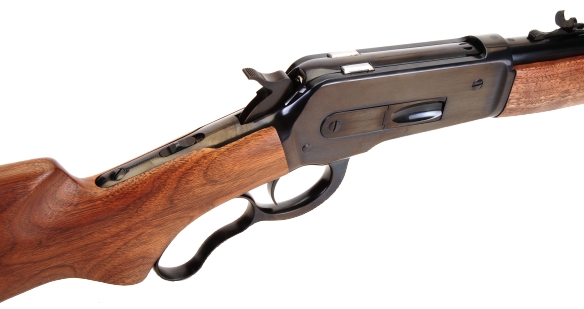
I’m glad to see these iconic Winchester rifles being produced. They are as relevant today as they were when they were first produced. A very slick gun, deeply blued and nicely figured satin finish walnut, but not too fancy to see a hunting camp. Is there any change I would make? …Nope. The Model 71 is right just the way it was received. For further information on the Winchester Model 71 and other similar products stop by the Winchester site.
Winchester’s 348 WCF Boomer… Part 1
Winchester’s 348 WCF Boomer… Part 2

Email Notification